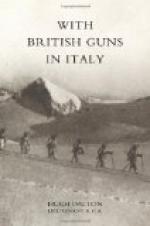The enemy trenches on San Marco lay out of view behind the crest, and our registration point, a white house on the top of the ridge, was almost completely blown away by a big French shell while we were watching, and waiting our turn to fire. We saw another shell burst in the Isonzo just above Gorizia, causing a huge waterspout. Colonel Canale arrived while we were firing. His white gloves were a little soiled, and he seemed rather worried and more serious than usual. He was disappointed at the stoppage of the offensive on the Carso.
CHAPTER XVI
THE FALL OF MONTE SANTO
Even when our guns were turned against San Marco, we continued to man Sant’ Andrea O.P., for one could get good general observation to the northward from the other side of the ruined house which was the old O.P., and most of the trenches on San Marco were invisible except from aeroplanes. I spent the night there several times during the August offensive, watching by turns with one of our Bombardiers, to whom I explained that wars were made by small groups of wicked men, generally also rich, sitting and planning in secret. I proposed to him the need to shell such groups, while they were yet forming, with the shrapnel of public opinion.
It was also at Sant’ Andrea that I met a young Lieutenant of Italian Field Artillery, a Sardinian from Cagliari. He had still the face of a child, and he had, too, that perfect self-possession and that wonderful, soft charm which are so often found together in the Italian youth. I think of him often with affection, and with an eager hope that he passed unharmed through all the vicissitudes which were to follow.
He and I spent many hours together, watching those bloody, memorable hills. I met him first on the 24th of August, and we drank a bottle of Vermouth together, and discussed with enthusiasm many subjects. We even worked out in detail a scheme for the interchange of students, for periods of a year at a time, between Italian and British Universities after the war. We then turned to modern history and I noticed that he did not respond as much as I had expected to the name of Garibaldi. He held the historical theory that, broadly speaking, there are no really great men, but only lucky ones. He put forward in support of this view the distribution of death, wounds and decorations in this war. This theory of history has in it larger elements of wholesomeness and truth than has, for instance, the pernicious bombast of Carlyle. I told my Sardinian friend that I had once heard it said by a most learned man that, if Rousseau had never lived, the world would not look very different to-day, except that probably there would be no negro republic in the island of Haiti. This saying pleased him and he was inclined to think it plausible.




